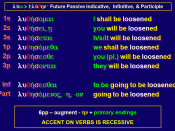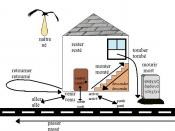INFINITIVES
Infinitives, usually, but not always, is preceded by to. While you normally think of only one type of infinitive (to + verb), there are actually four types:
Active Present: to drive Passive Present: to be driven
Active Perfect: to have driven Passive Perfect: to have been driven
Infinitives become difficult because they can function as a noun, an adverb, or an adjective. It is up to you to determine which one. Infinitives are similar to participles and gerunds in that they can have a direct object. By using the "key" (whom?/what? after the infinitive), you can determine whether or not the infinitive has a direct object:
Helen decided to accept the challenge.
Infinitive + whom?/what? = direct object
To accept + what? = challenge (challenge is the direct object of the infinitive)
Infinitives differ from gerunds and participles in that they can also have subjects. Gerunds and Participles cannot have subjects.
This subject always comes after the main verb and directly before the infinitive. What makes the subject somewhat difficult to identify is that it will look as it is the direct object of the main verb:
The student asked the teacher to help him.
In this sentence, it would appear as if teacher is direct object of the verb asked:
(subject + verb + whom?/what? = direct object
Student + asked + whom?/what? = teacher
However, in reality teacher is actually the subject of the infinitive to help. After you have located the infinitive and you have looked to see if the infinitive has a direct object, always look at the noun or pronoun to the left of the infinitive. If that noun or pronoun could do the action of the infinitive, then the infinitive has a subject. For example, can the teacher help? Yes. Well, teacher, then,


